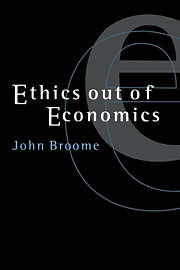Book contents
- Frontmatter
- Contents
- Preface
- 1 Introduction: ethics out of economics
- Part I Preference and value
- Part II The structure of good
- 6 Bolker–Jeffrey expected utility theory and axiomatic utilitarianism
- 7 Fairness
- 8 Is incommensurability vagueness?
- 9 Incommensurable values
- 10 Goodness is reducible to betterness: the evil of death is the value of life
- Part III The value of life
- Notes
- Bibliography
- Index
8 - Is incommensurability vagueness?
Published online by Cambridge University Press: 12 November 2009
- Frontmatter
- Contents
- Preface
- 1 Introduction: ethics out of economics
- Part I Preference and value
- Part II The structure of good
- 6 Bolker–Jeffrey expected utility theory and axiomatic utilitarianism
- 7 Fairness
- 8 Is incommensurability vagueness?
- 9 Incommensurable values
- 10 Goodness is reducible to betterness: the evil of death is the value of life
- Part III The value of life
- Notes
- Bibliography
- Index
Summary
Indeterminate comparatives
Which is more impressive: Salisbury Cathedral or Stonehenge? I think there is no determinate answer to this question. The dyadic predicate ‘more impressive than’ – the comparative of the monadic predicate ‘impressive’ – seems to allow indeterminate cases. Many comparatives are like that. Amongst them are many evaluative comparatives, such as ‘lovelier than’, ‘cleverer than’, and the generic ‘better than’.
For many comparatives, the indeterminacy arises because the comparison involves several factors or dimensions, and it is indeterminate exactly how the factors weigh against each other. The impressiveness of a building depends on some combination of its size, its importance in the landscape, the technological achievement it represents, and more, and it is indeterminate how these factors weigh against each other. Many evaluative comparatives are indeterminate for this reason. They depend on a combination of values, and it is indeterminate how the values are to be weighed. The values are incommensurable, we say.
Not all indeterminate comparatives arise from incommensurable dimensions, however. ‘Redder than’ can also be indeterminate, even though it presumably does not involve several factors. Compare some reddish-purple patch of colour with some reddish-orange patch, and ask which is redder. The answer may be indeterminate.
To make it clear: when I say a comparative ‘Fer than’ is indeterminate, I mean that for some pairs of things, of a sort to which the predicate ‘Fer’ can apply, there is no determinate answer to the question of which is Fer than which. Neither is Fer than the other, and nor are the two equally F. This chapter is about the logical structure of indeterminate comparatives, and in particular whether they are vague.
- Type
- Chapter
- Information
- Ethics out of Economics , pp. 123 - 144Publisher: Cambridge University PressPrint publication year: 1999
- 3
- Cited by



